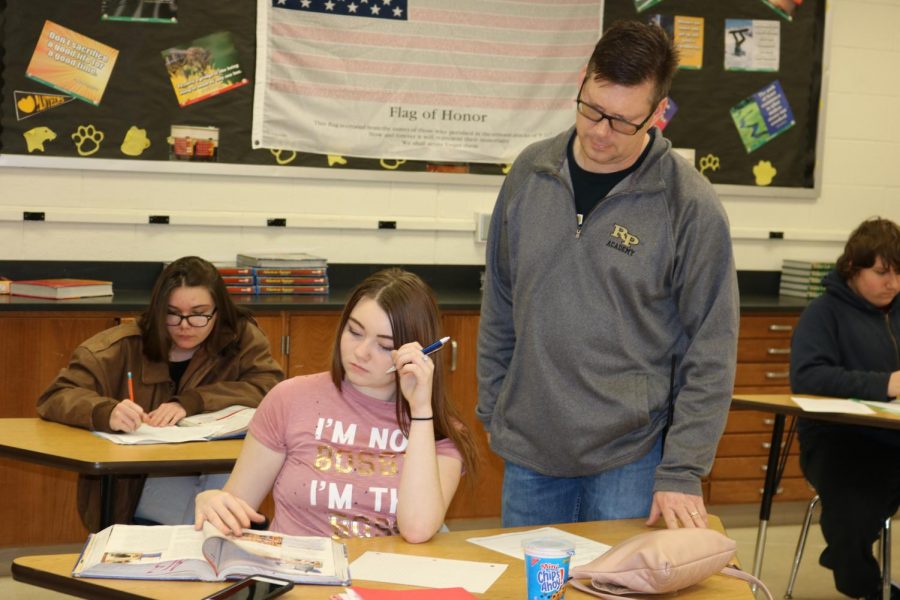Separate but united
March 21, 2018
A second chance is sometimes all it takes to get a student on the right path towards a bright future after high school. The academy offers this chance to many and all students.
The Academy was founded long after the high school was built and in business. Principal Jim Brown has been there since day one.
“I’ve been here for the whole ten years since we started it from scratch,” said Brown.
The Academy is a academic program outside from the high school that offers a chance for students get caught up in their work.
“The academy is a voluntary program generally for kids that are behind in credits for different reasons, and they can return to the high school if they wish,” said Brown.
There are many opportunities for students to transfer to the high school both at free will but also by order to improve their academics.
“We follow the same grade expectations as the high school, but we present the work differently We only have one math teacher, one english teacher, one science teacher, one history teacher so kids work on the equivalent of a college syllabus … and we give them packets. They work in the packets and if they pass it with a eighty percent higher they can move on… And make up some credits they got behind on,” said Brown.
Junior Natalee Varner has been at the academy since her freshman year in high school, because her sisters also went to the academy during their high school career.
“Both of my sisters went here so it was like a free ride for me,” said Varner.
To Varner, the classes are more relaxed than the high school, but at the same token, there is much more expected of them.
“It’s more relaxed, though we have more rules. Like we can’t have our phones or headphones,” said Varner.
Unlike the high school where they receive test and quizzes, Varner and many of her fellow classmates work in sections at their own pace.
“The workload is smaller than the high school since we work in contracts. Like in English we have three contracts and once we’re done with those three contracts we’re done with English,” said Varner.
Though it is a separate building the Academy goes through the same graduation as students at the high school. There are other options students have other than graduating with their class.
“Our Missouri Options Program is a little different, where if a kid is seventeen and behind in credits, they can qualify. We only run twenty kids a year through it,” said Brown.
Bruce Sharpe is in his twenty fifth year in teaching and is a teacher at the academy. He came from the middle school back when only the East Middle School existed.
“I came here for a change. The middle school was doing away with traditional grades and implementing 4-3-2-1 Standard Reference Reporting when I made the transition. Coming to a system where credits are all that matters is much more my style. The accountability of high school kids is where it should be….on the kid,” said Sharpe.
Unlike the high school, the academy has less teachers, meaning one teacher for each core class. The classes are not separated by grade or what science or math class they are in, thus the students work from the text.
“Our kids have limited choices for classes available. There are no AP or IB opportunities at the Academy. Academy students have to learn material on their own. They read and do work from text. Reading comprehension is the number one skill required here for a successful Academy experience. Our students are self-paced and motivated from within. The teacher’s role is in organization and encouragement. We walk from kid-to-kid checking their progress and offering assistance individually,” said Sharpe.
The curriculum of the academy has been simplified in both knowledge and level while in exchange to having to do test students are given list of assignments that they need to complete with a eighty percent or higher to pass.
“The academy is unique. We simplify curriculum. Contracts are really nothing more than lists of all the assignments for kids to do in order to earn credit. Since our program is reduced amount and level, our kids have to do work at or above the 80% mark in order to obtain credit. It’s really like “pass or fail”. The grades are A, B or F,” said Sharpe.
Grades are accumulated and calculated the same, as the high school Counselor Stacey O,Connell calculates both GPA and grades at the academy.
“GPA is calculated the same as the high school if a student earns a final grade that is less than 80%, the grade is changed to an F and that is what is on the transcript. We do not offer weighted classes at RPA,” said O’Connell.
Principal Steven Miller has been at the high school almost as long as the academy has been around. He sees the academy as a chance for kids to get their grades up.
“I do not like looking at the work as quantity, the academy is more set towards the students focus and pace allowing to play towards the student’s strengths,” said Miller.
Though separated both high school and academy allow students to graduate with their classmates, and offer a light into a bright future awaiting them to grab.




